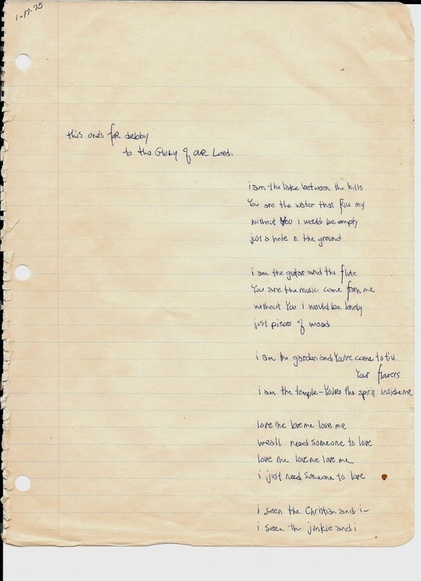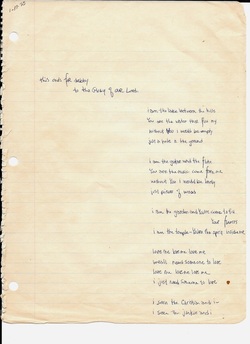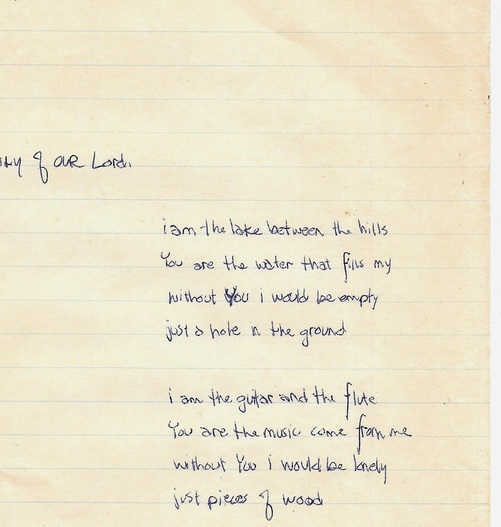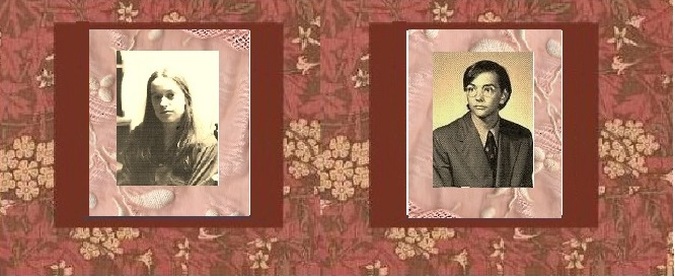
This is a brief analysis of a handwriting sample produced by Richard Wayne Mullins in January 1975 in response to a personal friend's request for one of his song lyrics. Debbie Blackwell Buckley, to whom this example was inscribed, has kindly given her permission to post it here. She witnessed him write these pages and affirms it is his own natural handwriting.
The pressure on the page is light; it does not leave a mark on the reverse side of the page. The left margin of the first page is enormous, indicating a devotion to artistic form and a high degree of ambition. The entire song is presented on precisely two pages, not a line more or less. This demonstrates keen mental organization and intellectual process. The second page presents a substantially more moderate left margin, revealing that the writer has recalled and accommodated the somewhat longer lines in the second half of the lyric. Memory and planning are notable strengths.
The writer's favorite poet at the time of this writing was E.E. Cummings. Choosing to emulate Cummings' style, Mullins has left out out all punctuation and capitalization, with one exception. The lack of punctuation lends a transcendent quality to the written lyric, as though leaving the reader to envision alternate phrasings: an invitation to interpretation. Like Cummings', Mullins' personal pronoun "I" is formed as a lowercase letter. While this may indicate humility or a tendency to identify with everyman, it may also hint at a diffusion of personal accountability, and perhaps an alienation from family ties. His signature shows the same lack of capitalization. These conventions characterized E.E. Cummings' work, but Mullins deliberately chose to adopt them at this phase of his life, demonstrating his personal affinity with these poetic forms.*
*Later in his life, Mullins re-adopted the use of standard punctuation and capitalization. This intermittent phase seems to have been fairly short-lived, possibly starting before he began college and ending sometime in his college years. Mullins told me that he was placed in the lowest section of his Freshman English class, although I found it difficult to believe. If he was leaving out capitals and punctuation, this may account for his low placement. Mullins himself did not seem to care, showing no hurt pride about his placement. He was just as content with easier assignments, which gave him more time for music.
The writer uses the capital letter form only when referring to God. But it is noteworthy that his second reference to God is begun by forming a lowercase "y," overwritten with an uppercase "Y." This alternation suggests that like many great poets, the writer superimposes a divine relationship on a human one--or uses one to represent the other. The shape of this uppercase Y is, as far as the analyst can tell, unprecedented in handwriting literature. A remarkable degree of creativity is displayed in this letter, shaped like a goblet or a chalice—or perhaps like the Grail.**
**The writer had a fascination with the Grail legends when he wrote this sample.
There is a fluidity to the writing as it appears on the page, an effortless expression of creativity and rhythm. The lowercase "i"s are carefully dotted, falling neither to the left or right of the "i" stem. This is an indication of precise attention to detail, active memory and personal loyalty. The writer's signature is the same size as the rest of his writing and contains no capital letters, demonstrating the consistent nature of his personal humility.
The writing shows a tendency to stray below then line, then revert to it. Together with his slightly left-leaning, alternated with a slightly right-leaning slant, it appears the writer is moody, prone to depression, and at times acts out a dual nature, an almost simultaneous push/pull in relationships.
The miniscule size of the writing, the close spacing of letters within words, and the greater distances between words suggest the writer is capable of an intense degree of concentration yet remains highly private about his inner life. It is more than a need for space, indicated by the large spaces between words; more than a difficulty letting people in, shown by the tight spacing of the letters within words. The tiny writing shows his extreme introversion and a brilliant intellect capable of handling an overwhelming amount of detail. Einstein and Da Vinci both had small handwriting. This writing is approximately 3/4 the size of Albert Einstein's--very small indeed. The light pressure on the page indicates a highly sensitive nature. All these factors together suggest his feelings tend to be pent up; when he does express them, he may lose his temper abruptly. The precise closures of his vowels indicate integrity. He will be honest, on his own terms. However, he is fully capable of keeping a confidence--which means he won't tell everything he knows. The man who wrote this sample shows indications of being an extremely lonely individual who is reluctant to communicate how he really feels.
What motivates this writer?
Not every handwriting sample reveals so clearly the writer’s personal vortex. This writer appears to be obsessive.
What is the focal point of his obsession? This would be demonstrated by the letters of the words he overwrites: the y in "you" and "You." His concept of a relationship with God is superimposed on a human relationship. There is inherently nothing wrong or evil or sinful about this, as the Song of Songs demonstrates. This writer is obsessed with the idea of such a relationship.*** The focal point of his obsession, it is the vortex on which his life spins, because personal intimacy is his Achilles heel: the weakest link in his personal inventory.
***Tellingly, the writer believed obsession to be a characteristic of divine love.
For some larger views of this sample, click here
For some notes on this analysis, click here
This is the seventh in a series of posts about the upcoming book, Let the Mountains Sing. The eighth is here.





 RSS Feed
RSS Feed
